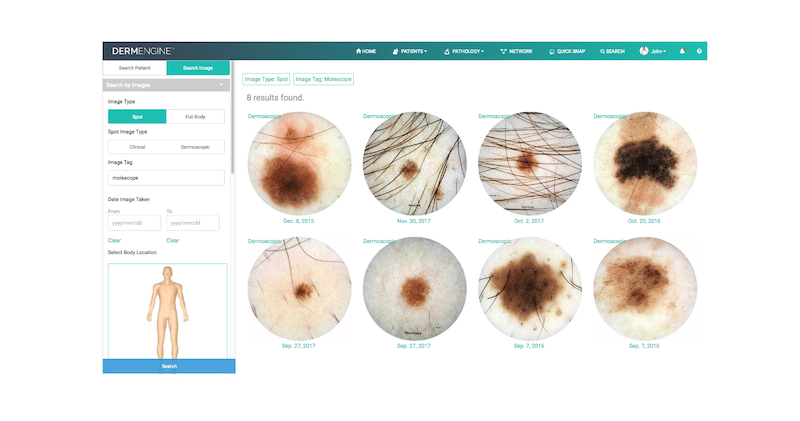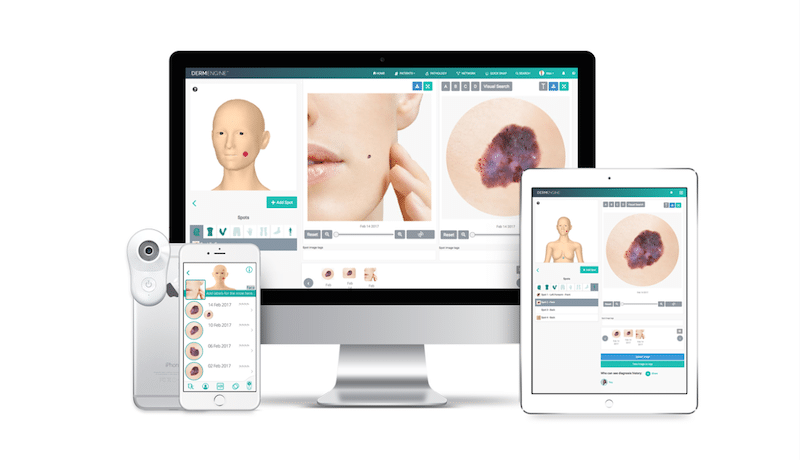A Conversation with Maryam Sadeghi, DermEngine CEO

 In 2014, Maryam Sadeghi received a phone call from her PhD advisor, Dr. Stella Atkins, who was concerned that she may have a melanoma. At the time, Sadeghi had just created a prototype for their MoleScope device, a digital dermatoscope that could image skin spots to identify different types of skin cancers. Dr. Atkins, who has an extensive research background in skin cancer imaging and diagnostics, had been testing the prototype.
In 2014, Maryam Sadeghi received a phone call from her PhD advisor, Dr. Stella Atkins, who was concerned that she may have a melanoma. At the time, Sadeghi had just created a prototype for their MoleScope device, a digital dermatoscope that could image skin spots to identify different types of skin cancers. Dr. Atkins, who has an extensive research background in skin cancer imaging and diagnostics, had been testing the prototype.
As Sadeghi recalls the moment, she says, “Dr. Atkins was like, ‘Look at this mole on my leg’. Our team had some algorithms back then based on my PhD work to detect abnormal structures in dermoscopy images, so we tested the mole and the device flagged that it was irregular. Later, my advisor booked an appointment with a doctor and they confirmed it was a melanoma.”
It was a bittersweet moment for Sadeghi. She recalls, “I remember I was so sad and Dr. Atkins was like, ‘Maryam, this is great! MoleScope helped find my melanoma. This technology is going to help so many thousands of patients’.
“I still have goose bumps when I talk about it… she had worked in medical imaging and cancer diagnostics for over 28 years, and I told her, ‘Your dedication to this field has paid back. As your student, you helped me to get the training and design the project that helped you find your melanoma’.”
Later, Maryam Sadeghi and her team designed the DermEngine platform to bring this technology and their AI algorithms to many more doctors and patients across the globe.
Meet Maryam Sadeghi
Maryam Sadeghi may just be the biggest deal in dermatology that you’ve never heard of. A true pioneer, she’s the CEO of MetaOptima, a company that creates intelligent digital tools for the field of dermatology, to improve skin cancer outcomes.
An Iranian-born Canadian resident, Sadeghi earned her PhD in computer science from Simon Fraser University (SFU) in the area of medical image analysis. In 2012, not only did she and her co-founder Majid Razmara start MetaOptima, but she also won the Doctoral Dissertation Award from the Canadian Image Processing and Pattern Recognition Society (CIPPRS) for her PhD thesis.
Since then, it’s been one honour after another with Sadeghi winning WaveFront’s Wireless Prize package in the 2013 BCIC-New Ventures Competition and a prize in the 2014 Plug & Play Silicon Valley competition. In 2018, BC Business Magazine named her one of ‘BC’s Most Influential Woman in Health Tech’.
And, most recently, RBC named her among the 2019 ‘Top 25 Canadian Immigrants’.
What MetaOptima does
Clearly, MetaOptima is a big deal and for good reason. The company has created two revolutionary products that are changing the field of dermatology as we know it.
The first, DermEngine, is a platform for imaging, documentation, communication and diagnosis of skin conditions. DermEngine provides mobile, tablet and web access to images, clinical notes and pathology reports for doctors and patients, and integrates with 90% of the practice management solutions and EMRs on the market in Australia.

The second product, called MoleScope, is a smartphone-attachable dermatoscope that’s used to scan moles, for tracking changes over time and diagnosing skin cancers. The device integrates with the DermEngine platform, producing high-quality pictures that meet the current standard of care for skin cancer diagnosis and management.

A gap in the market
These innovative products were forged by Sadeghi’s experience working in one of the top dermatology and cancer centres in Vancouver.
She explains, “By training, I am a computer scientist. I did a PhD in computer science, machine learning and medical imaging. I also had a 3-year training and scholarship in skin research and dermatology.
During my studies, I was shocked at how archaic the system was. I was working in one of the world’s top dermatology centres in Vancouver and there was really no digital system for documentation. The workflow was very archaic and under-digitised.
“Because I came from a medical imaging background in radiology and MRIs, which was all digitised, I was really surprised.
“Then I learned that skin cancer is the most common type of cancer. 1 in 7 Canadians, 1 in 5 Americans and 2 in 3 Australians will develop skin cancer in their lifetime. So, I saw there was a big problem and a big gap in the way things were operating.
“I was also surprised and shocked to learn how a skin cancer diagnosis was made. I thought there would be solid science behind it, but it wasn’t like that.
“As a computer scientist with training in skin cancer and dermatoscopy, I immediately recognised that this was purely a pattern recognition problem. It was all visual training by example. It was like, if you see enough similar cases you get good at recognising things. This got me thinking, if you’re trained by just learning visual clues for cancerous skin disease, then there’s a good chance a machine can help our doctors as a second opinion.
There are over 150 million patients worldwide who have skin cancers identified and there are many more people out there that need to be screened. So, there’s a huge volume of people who need a quality service and yet we have limited access to these specialists.
“Canada is about the same size as Australia. We have about 500 specialist dermatologists in the country and most of them are in the big cities. So there really isn’t fair access to quality care for all of our patients.
“Anyway, I started putting all of this together and it was very obvious that we could help provide a solution to improve digitisation and communication, as well as an AI (artificial intelligence) solution for clinical decision support.
“I was lucky to have Majid Razmara as my best friend, husband and co-founder. He’s the CTO of MetaOptima. He also has a PhD in machine learning and computer science. Really he’s the brain behind the product.
“Together we just knew that there was a big need and I was sure this was going to happen – that we’d have evidence-based diagnosis decisions. One day, I remember thinking, it has to be someone like us to create such a platform, because we have the training in computer science and the training in dermatology.”

Early days
Although both Sadeghi and Razmara had backgrounds in AI, they didn’t feel artificial intelligence was the best place for MetaOptima to focus its energies initially because there was no infrastructure in the market.
“At the beginning, we thought, let’s forget about AI for now. Instead, we need to help doctors with what they do every day. We need to solve their problems with workflow efficiency, documentation and communicating with patients,” Sadeghi explains.
“So we started with the platform first. It was our intention to introduce our AI tools slowly over time, because I think the adoption of technology is actually a lot more important than the building of the technology. After all, if nobody’s using it, it’s not going to get anywhere.”
When the company finally did move on to AI, the focus was always on explainable AI.
“I didn’t like black box AI where all the machine said was ‘70% chance of skin cancer’,” Sadeghi says. “I thought, no, the doctor needs to know how the machine came up with its answer because that’s how doctors think and assess things. So instead, our AI says, ‘I see this, I’ve had some similar cases, similar cases were melanoma’ – because that’s actually how a dermatologist makes a decision.”
A scalable solution
For many dermatologists, the latest and greatest technological devices may be unaffordable. Fortunately, MetaOptima has made their products easily attainable for medical clinics of all sizes.
Sadeghi says, “Our big focus was on building a product that was scalable and affordable for the masses. We didn’t want to build just another machine that was going to be expensive and only available to the big centres. It needed to be available to primary care doctors in the front line, and our dermatologists who are serving thousands of patients in thepublic health system.
Today, we have about 400,000 patients. The adoption is mainly coming from major skin cancer centres, hospitals and primary care.
“You’ve probably heard about these big machines on the market that only big centres can afford. They run all the way from $70,000 to $300,000. Primary care physicians and dermatologists can’t afford these machines first off, and some may also not have the real estate to bring these machines in because they’re so enormous.
“So, the idea behind DermEngine was to build a technology that was more affordable and more accessible. That’s why we focused on software, not hardware, and set up a pay-as-you-go subscription model, so you only pay for what you use.
“So far, the feedback from our doctors is that the system is scalable for them.”
Award-winning AI
By now you might be wondering just how good this affordable product is. Well, the results are speaking for themselves.
When MetaOptima entered 3 of its algorithms into a global AI competition to detect 7 different kinds of skin diseases, including skin cancers, their algorithms came in first, second and third, with the highest accuracy at 88.5%. This is better than a lot of human experts around the world.
Sadeghi explains, “When you look at the results published recently in Lancet Oncology, the sensitivity of human experts was 81.2% vs. 88.5% for our algorithms.
“And in terms of the accuracy, the area under the curve for the prediction of malignancy was 95.8% for human readers, while our AI algorithms reached 96.3%.
“With a sensitivity of about 96%, the specificity for our algorithms was about 80%, while the average human readers reached a mean sensitivity of 76%, and specificity of 78%. Of course, the group of human readers with more experience performed better than the average, but still the AI algorithms outperformed the average human.”
A valid second opinion?
So, the DermEngine AI works well, but can you rely on its accuracy with real patients? After all, the consequences of the machine’s failure have much greater stakes in the real world than they do in a competition.
When asked how this device stacks up next to a specialist, Sadeghi says, “It’s obviously dependent on the level of training and experience our doctors have, but the study and the numbers are shedding light on a really important topic. The machine and AI has the potential to help here.
“For example, they say that the typical number for primary care doctors is 95% false positive when it comes to finding a melanoma. That means they cut 20 lesions to find one melanoma.
“For the top dermatologists, it might be 1 to 4 or 1 to 3. Sure, there may be a dermatologist in this world who’s better than that. I’m not saying there isn’t, but the best ones I know are like 1 to 3, so they cut 3 lesions to find 1 melanoma.”
While that may sound critical, Sadeghi is quick to point out that those numbers are completely understandable when patients’ lives are on the line.
“I’m not blaming any doctor who is cutting out and not finding cancer, because if you tell me I have a 10% chance of having melanoma, I will ask you to cut it out. A 10% chance of melanoma is high risk. Our doctors are trying to play it safe.
“I just think if we had an educational tool that could show doctors the statistics based on thousands of cases and say, ‘That’s a 75% chance of melanoma’, then they’d have greater confidence to do it. Or, if you were to say, it’s only a 2% chance of melanoma from thousands of similarly found cases, then maybe you’d want to monitor it and not just cut it out right away. At the end, it is all about how we incorporate AI in our clinical workflow to support our doctors.”
“It is very important to note that, although AI algorithms may outperform human experts in nearly every aspect of a study, higher accuracy in a diagnostic study with digital images does not necessarily mean better clinical performance or patient management in real-life settings. The technology needs to be designed and validated in clinical settings.
“Therefore, the tools with diagnostic claims can only be added to the system when validated and approved by local regulatory bodies in real-life clinical settings. In the current DermEngine system, our AI tools are added for educational purposes and workflow efficiency only, but we are in the process of running prospective clinical studies to add the clinical diagnostic tools in the near future as well.”
The limitations
Although dermatologists may feel relieved by this new technology, that relief may be fraught with some anxiety. After all, is it possible their unique skills could be replaced by a tool?
Not at all, says Sadeghi. In fact, she stresses that the technology is in no way meant to replace or compete with specialists. Instead, it’s more like an intelligent assistant that can help them do their job better.
“The technology is not for making a final diagnosis. I believe our doctors should treat the AI as their intelligent assistant. I actually talk a lot at conferences about what you should expect from an intelligent machine and what you shouldn’t expect, and how you should utilise the AI to be effective,” she says.
“For example, the AI is trained on a comprehensive set of images with labels, but the AI doesn’t know your patient’s history. It doesn’t necessarily have the metadata and it doesn’t have all the information that the doctor has about the patient. It’s not communicating with your patient or asking questions that you’re asking the patient.
Doctors should see this as an affordable, accessible, intelligent assistant to offer a second opinion, but ultimately, they should make their own decision. They shouldn’t just agree with the AI. They should be able to say, ‘You know, I know my patient better, I’m going to cut it out because I see differently’.
“What I say to our doctors is that AI will not replace you. AI will be your assistant that has the collective knowledge of thousands of doctors who have seen millions of patients, but it will still just be an opinion.
“It’s like showing the case to a colleague to get their opinion. You’ll take that opinion on board, but at the end of the day you will decide for yourself, because they’re your patient.”
The future for MetaOptima
As exciting as MetaOptima’s products are, you might think that the company couldn’t possibly top them… but you’d be wrong. After all, there’s a reason Sadeghi’s won so many awards!
When asked about what’s in store next for MetaOptima, Sadeghi says, “It’s a mini drone, called DermDrone. DermDrone is designed to be your automated assistant for documentation and imaging.
“We realised that a big problem in a skin cancer exam is that the GP will spend 25-30 minutes just taking photos and documenting the images. We thought that our doctors and specialists’ valuable time was perhaps being wasted on these tasks. So, we started looking for a better, faster, and more effective solution.”
Enter DermDrone, a mini drone that can scan a patient in real-time.
“The drone is intelligent, so it can identify the patient through facial recognition. It flies around the patient taking photos and then saves everything to the patient file as a 3D body map. These photos are then compared to photos taken during the previous exam.”
Sadeghi explains, “Of course, it has to go through regulations and clinical analysis and validation, but we are hoping to have the pilot in 2020. Our first prototype is already working. It can complete the exam and take the images, but we want to improve the camera quality and add extra lighting.”
If you’re having fears of medical malpractice suits after crashing a drone into a patient’s face, you’ll be relieved to know that Sadeghi has already taken this into consideration.
“Obviously, we are not asking our doctors to fly it. That’s the last thing I would actually ask them to do,” she says with a laugh.
“The idea is that the drone is sitting on this nice diamond base on the doctor’s desk and they can launch it by clicking, ‘Scan the patient’ on DermEngine. The drone will then scan the patient and return to the desk to recharge itself. All the imagery and documentation can be completed in 3 to 4 minutes.”
To stay abreast of what MetaOptima is working on, or to learn more about the company’s dermatology solutions, visit dermengine.com. You can also follow Maryam Sadeghi’s work in the dermatology field by visiting her LinkedIn profile.



